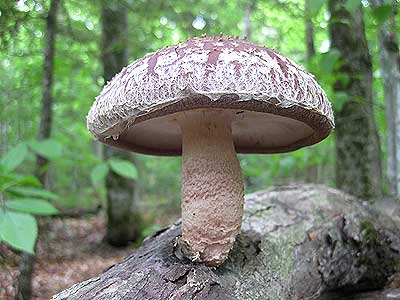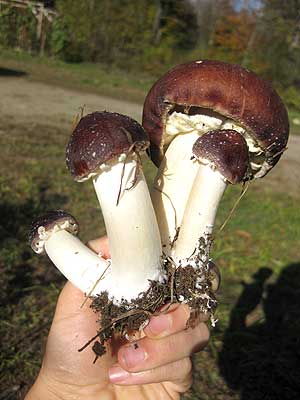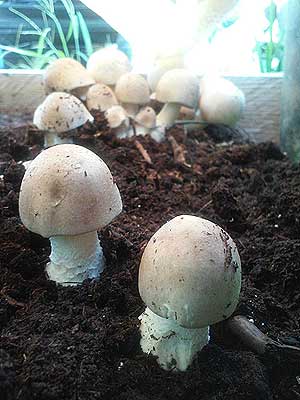 |
| Shiitake mushroom |
 |
| Wine cap or king stropharia mushrooms |
 |
| Agaricus mushrooms |
By Geoffrey Nosach
Every farmer and gardener works in concert with the kingdom of fungi. The composting process relies on native fungal friends to convert carboniferous materials into a rich humus, which in turn provides the soil fertility we need to grow crops. Primary, secondary and tertiary decomposers work in succession and can be used intentionally to bring forest and pasture products home to bear fruit in the garden. Three common species can be wonderful allies in this natural process.
Shiitake (Lentinula edodes)
The shiitake mushroom, a primary decomposer, has been cultivated for thousands of years. Natural cultivation on hardwood logs is the oldest and simplest method. Any farm that has a suitable woodlot or access to hardwood tree tops can use this method during the winter and enjoy the fruitings every spring and fall.
Shiitake grows best on 3- to 8-inch-diameter oak, beech, maple, birch or ironwood logs. Many other species will work, but oak and sugar maple are preferred and can fruit for many years. The logs should be freshly cut when no leaves are present and inoculated within a month for best results. To inoculate, drill shallow holes along the length of the log every 6 inches in rows spaced 2 inches apart. Then fill these holes with pure culture sawdust spawn, which can be acquired from a spawn producer. Cover holes in melted beeswax or soy wax to keep out pests and preserve moisture. Next incubate the logs by tightly stacking them up in full shade and covering with a tarp for six months to a year. After incubating, preferably in early spring, arrange in 4-foot-tall crib stacks in regions that receive plenty of rainfall and in shorter stacks in less humid areas with hotter summers. The natural fruiting cycle begins the following spring or fall. Shiitakes store well in a cardboard box, refrigerated for up to two weeks, and can be dried for long term storage.
Shiitake cultivation complements thinning and harvesting of hardwood stands. Firewood dealers, for example, tend to split only logs bigger than 8 inches, chipping the rest, and therefore might make good partners for shiitake farmers. Landscapers and tree services often create suitable waste material, especially in affluent areas of the Northeast where giant hardwoods dominate the landscape. In 2012, Hurricane Sandy created an enormous pile of downed hardwoods. A well organized group of shiitake farmers with saws in hand might have greatly offset the enormous cost of cleanup and made a mushroom profit to boot!
Wine Cap (Stropharia rugosoannulata)
The king stropharia is probably our greatest ally in converting carbon-based debris into fertile soil. Enthusiastic farmer-recyclers can use this strain to boost yield in the garden and flavor at the dinner table. As both a primary and secondary decomposer, this mushroom rapidly breaks down complex carbon chains and enables important fungal-bacterial relationships in soil. In the course of one rainy year, I have seen piles of mixed wood chips turn into piles of rich worm castings and have eaten huge amounts of wine cap! This species can rapidly break down wood chips, paper products, straw, hay, brush, corn husks and more. Since stropharia relies upon diverse bacteriological soil associations, it thrives in nonsterile environments and can be inoculated repeatedly so long as it has plenty of food.
Both farmer and gardener use mulch to preserve topsoil and increase soil fertility. Garlic is often heavily mulched to inhibit weeds and protect its tender shoots over winter. This mulch hay or straw can be inoculated during application in the fall, and around harvest time a crop of mushrooms can appear between garlic rows! Any mulched bed can be a boon to the wine cap cultivator. Stropharia quickly chews through grass mulch, often fruiting six months from inoculation. As a general rule it prefers straw to hay and brown, higher-carbon, late-season hay to earlier, greener, higher-nitrogen cuttings.
The favorite food of king stropharia is wood debris. Will Bonsall, in his book “Radical, Self-Reliant Gardening,” encourages us to use ramial wood chips to nutrify barren or exhausted soil. Ramial wood chips are branches no larger than 3 inches in diameter from hardwood trees. The ramial tree tops can contain up to 10 times the nitrogen as stumpwood. Citing forestry researchers from Laval University in Quebec, he describes how large scale agriculture operations adjacent to working hardwood forests would enrich their fields with overwintered ramial mulch waste applied thinly over the dormant fields. In early spring, the chips, which have been significantly decomposed by cold-hardy white-rot fungi, are lightly tilled into the fields. King stropharia happens to be one of the most ferocious of the white-rot fungi, and I would argue that it can decompose stumpwood chips nearly as rapidly. Within months of inoculation, chips are white and spongy, so worms can begin to move in and convert this cellulose into rich and fertile castings. Intentional fungi farmers might add a harvest of delicious gourmet mushrooms to their yield!
At the Mercer Mushroom Museum, a small mushroom farm in Mercer, Maine, we receive deliveries of mixed wood chips from local tree services. We spread these chips as walking paths between garden beds and as weed suppressing mulch under our fruit trees. The resultant fruit and fertile worm castings do not go to waste.
Chips can be inoculated with pure culture spawn, fresh stem butts or handfuls of spawned chips from existing patches. Spread the chips in early spring, up to 8 inches thick, and bury spawn a few inches below the surface, a small handful per square foot. Keep well watered at first and through the dry season. Harvest should begin when autumn rains arrive. Add more chips seasonally, as stropharia moves on once its food supply is exhausted. Harvest mushrooms when young, before the cap begins to open. Slice lengthwise and fry in butter with chopped garlic until slightly crispy outside. Wine cap has the texture and slight flavor of asparagus. Delicious!
Agaricus Species
Many Agaricus species are available; the common white button, crimini and portobello are the most popular. We prefer to grow a heat-loving, almond-flavored species, Agaricus subrufescens, as few other species fruit in late summer. In chilly central Maine we raise the almond agaricus in our small greenhouse to take advantage of the extra warmth and humidity.
Agaricus species are tertiary decomposers and find their niche in compost piles and leached manure. You can prepare compost by piling, watering and turning straw or hay – or by letting stropharia have a go at it. In fact, one might be able to grow shiitake on logs, which are later chipped into stropharia beds, the compost from which is then spawned with agaricus! I found this idea in Paul Stamets’ book “Mycelium Running” – required reading for anyone interested in cultivating mushrooms. Although wonderfully beautiful in concept, this sequence may be difficult in practice, so I recommend using ready-made composts for greater yield potential.
Pile fresh manure in short, pyramidal stacks in early summer and cover the stacks with tarps. The core temperature will reach up to 120 to 140 F. After a week or so of these high temperatures, most of the ammonia smell dissipates. The pile will soon cool to about 100 F and should become darker in color and smell sweeter. Then it is safe to spread into beds approximately 8 inches deep.
We use pure culture sawdust spawn at a rate of one small handful per square foot. Form a tight ball of spawn and bury it a couple of inches below the surface. Depending on temperatures, mushrooms should develop in six to eight weeks. Yields increase significantly if beds are covered with a thin layer of pH-buffered (limed) peat moss.
Humidity is important to all mushroom species, especially during fruiting, and they generally prefer shade. Heavy feeders such as tomatoes can be transplanted directly in mushroom beds or in adjacent rows to provide a shady, jungle-like canopy, trapping humid air underneath. Always keep the bed well moistened without over watering.
Stropharia is the most foolproof mushroom to raise, with shiitake a close second and agaricus being more difficult; but all three can be grown with simple techniques and common tools at home.
Pure culture sawdust spawn can be acquired from trusted producers locally or from these sources:
North Spore
www.northspore.com
[email protected]
207-352-0264
Field & Forest Products
www.fieldforest.net
800-792-6220
[email protected]
Fungi Perfecti
www.fungi.com
800-780-9126
[email protected]
About the author: Geoffrey Nosach is an artist, timber framer, veggie bus mechanic and mushroom farmer who lives with his wonderful growing family in Mercer, Maine.
